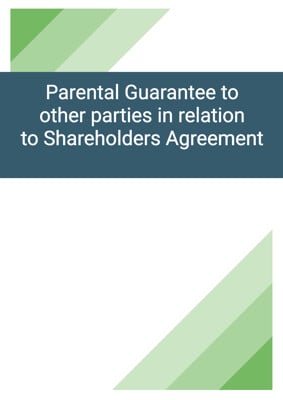How to Tailor the Document for Your Need?
01
Create Document
Fill in the details of the parties. You can click the "Fill with Member’s Information" button to complete it with information saved to your account.
02
Fill Information
Please fill in any additional information by following the step-by-step guide on the left hand side of the preview document and click the "Next" button.
03
Get Document
When you are done, click the "Get Document" button and you can download the document in Word or PDF format.
04
Review Document
Please get all parties to review the document carefully and make any final modifications to ensure that the details are correct before signing the document.
Document Preview
Document Description
This shareholders agreement is a legally binding document that governs the relationship between Party 1 and Party 2 as shareholders in a jointly-owned company. The agreement highlights the importance of forming the company and outlines the terms and conditions that will guide the shareholders' relations. It provides a detailed interpretation of key definitions used throughout the agreement, ensuring clarity and understanding for both parties. The agreement also covers the establishment of the company, including the incorporation process and the completion of necessary events and transactions. It specifies the share capital of the company and allows for the increase of share capital by mutual agreement. The agreement further addresses the capital and further finance of the company, including provisions for additional financing and the repayment of loans. It outlines the composition and responsibilities of the board of directors, including the appointment and removal of directors, quorum requirements, and voting procedures. The agreement also includes a section on reserved shareholder matters, which require the prior approval of both parties. It covers the transfer of shares, including the process of giving transfer notices, the right of first refusal, and the determination of fair prices. The agreement emphasizes the importance of confidentiality and imposes obligations on both parties to keep any information regarding the company or the other party confidential. It prohibits both parties from engaging in competing businesses during the term of the agreement. The agreement has a minimum term and allows for termination by either party with prior notice. It specifies that the agreement supersedes any previous agreements or understandings between the parties. The agreement also includes provisions on costs, the absence of a partnership or agency relationship, and the assignment of rights and obligations. It states that no third party has the right to enforce any terms of the agreement. The agreement includes a dispute resolution clause and outlines the requirements for giving notices and serving legal proceedings.
How to use this document?
To use this shareholders agreement effectively, follow these steps:
1. Incorporation: Ensure that the company is incorporated in the agreed jurisdiction as a company limited by shares. Follow the specified characteristics, including the company name, authorized share capital, and registered office.
2. Completion: Complete the establishment of the company by fulfilling the conditions precedent, if applicable. This includes subscribing for shares, issuing share certificates, and entering into ancillary agreements.
3. Capital and Further Finance: Understand the share capital structure of the company and the provisions for increasing share capital. If further finance is required, approach the company's own bankers first. If necessary, provide guarantees for the company's liabilities in equal proportions.
4. Directors and Management: Establish the board of directors with representatives from both parties. Appoint and remove directors according to the agreed process. Ensure the quorum requirements are met for board meetings and follow the voting procedures. Provide notice and agenda for board meetings.
5. Reserved Shareholder Matters: Obtain prior approval from both parties for matters listed as reserved shareholder matters. These include significant decisions related to shares, borrowing, contracts, and more.
6. Transfer of Shares: Follow the process for transferring shares, including giving transfer notices and offering shares to the other party at a specified price. If the other party does not exercise the right of first refusal, the selling party can sell the shares to a third party.
7. Confidentiality: Maintain strict confidentiality regarding any information related to the company or the other party. Ensure that employees and agents also adhere to this obligation.
8. Restrictions on the Parties: Neither party should engage in any competing business during the term of the agreement, except for permitted investments.
9. Term and Termination: The agreement has a minimum term and can be terminated by either party with prior notice. Follow the specified notice period and initiate the liquidation process if necessary.
10. Supremacy of the Agreement: Ensure that the provisions of this agreement are followed and take precedence over the memorandum and articles of the company.
11. Costs: The costs of incorporation are borne by the company, while each party is responsible for its own costs related to the preparation and execution of the agreement.
12. No Partnership or Agency: Understand that the agreement does not create a partnership or agency relationship between the parties.
13. Entire Agreement: Recognize that this agreement, along with any other agreements entered into on completion, constitutes the entire agreement between the parties, superseding any previous agreements or understandings.
14. Assignment: Do not assign this agreement or any rights or obligations without proper authorization, except for the transfer of shares as permitted.
15. Conditions Precedent: If applicable, ensure that the conditions precedent are fulfilled or waived before completion.
16. Amendment: Any variation of the agreement must be in writing and signed by or on behalf of both parties. Variations do not affect rights, obligations, or liabilities that have already accrued.
17. No Rights of Third Parties: Understand that third parties do not have the right to enforce any terms of the agreement.
18. Dispute Resolution: Follow the specified jurisdiction clause for resolving any disputes that may arise.
19. Notices and Service: Give notices in writing, following the specified methods of service and addresses. Ensure that any changes to addresses are properly communicated.
20. Sign and Execute: Sign the agreement with the duly authorized representatives of both parties to make it legally binding.
Not the right document?
Don’t worry, we have thousands of documents for you to choose from:


























